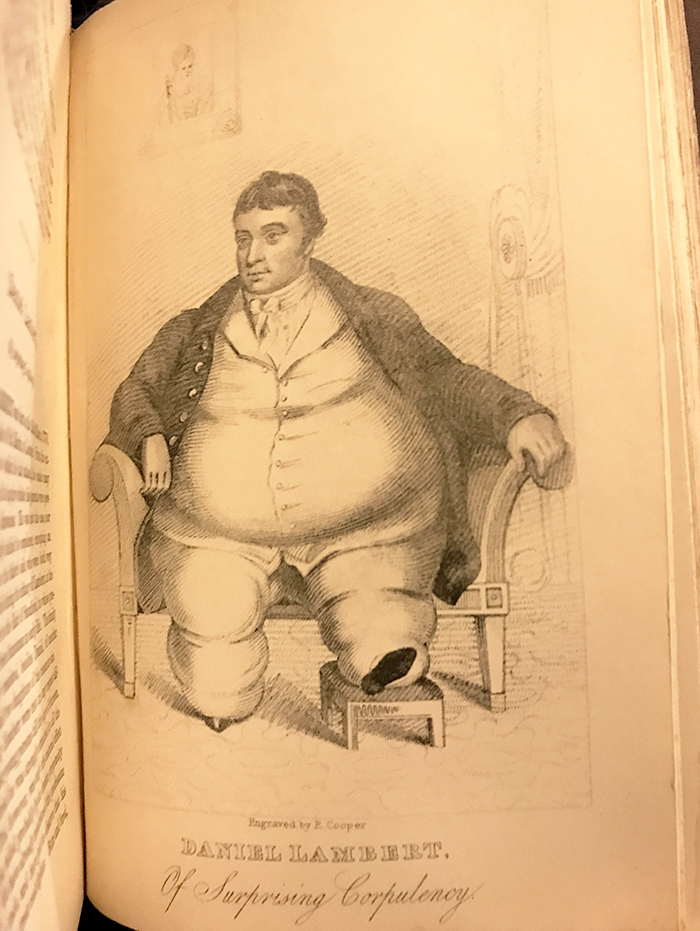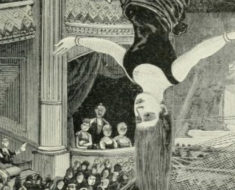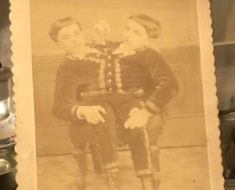Had Daniel Lambert been alive today, he would’ve carted his more than 700 pounds around in a motorized scooter, as too many morbidly obese people choose to do. But in the early 1800s, such amenities weren’t available, because there was no market for them. Lambert was a true anomaly. And people couldn’t get enough of him.
Lambert, once known as the fattest man in England, is the first heavyset man believed to make a living by exhibiting his weight.
Born on March 13, 1770 in the parish of St. Martin, at Leicester, Lambert grew up bigger and more powerful than other kids. He enjoyed swimming, and while in the water, he could reportedly carry two men of ordinary size on his back. He enjoyed other sports as well, including cockfighting, dog racing, and fishing.

Daniel Lambert, as illustrated in The Book of Remarkable Characters, by Henry Wilson and James Caulfield.
Lambert’s weight increased steadily as he reached adulthood. By age 23 he weighed 450 pounds. But before decided to become a professional fat man, he held a job as the keeper of the town’s prison. This position lasted until 1805, at which time the facility closed. Lambert was left with a 50-pound annuity.
By this time Lambert’s size had grown considerably—and so did his reputation. Curiosity seekers wished to see this unusual man for themselves, but Lambert had no desire to put himself on display for anyone. The Book of Wonderful Characters (1869), by Henry Wilson and James Caulfield, shares this amusing anecdote:
A gentleman travelling through Leicester conceived a strong desire to see this extraordinary phenomenon; but, being at a loss for a pretext to introduce himself, he first took care to inquire what were his particular propensities. Being informed that he was a great cocker, the traveler thought himself sure of success. He accordingly went to his house, knocked at the door, and inquired for Mr. Lambert. The servant answered that he was at home, but that he never saw strangers. ‘Let him know,’ replied the curious traveler, ‘that I called about some cocks.’ Lambert, who chanced to be in a situation to overhear what passed, immediately rejoined: Tell the gentleman that I am a shy cock.
Such cases began happening all too often and Lambert realized that he, a former keeper of the prison, was becoming a prisoner in his own home.
![Daniel Lambert. Image credit: Benjamin Marshall [Public domain], via Wikimedia Commons](https://www.weirdhistorian.com/wp-content/uploads/2017/10/Benjamin-Marshall-Public-domain-via-Wikimedia-Commons.jpg)
Daniel Lambert. Image credit: Benjamin Marshall [Public domain], via Wikimedia Commons
Of course, not everyone treated Lambert well. When they were obnoxious, the large man returned the favor.
Wilson offered this example: “A person asking him in a very rude way the cost of one of his coats, he returned him no answer. The man repeated the question with the observation that he thought he had a right to demand any information, having contributed his shilling, which would help to pay for Mr. Lambert’s coat as well as the rest. ‘Sir,’ rejoined Lambert, ‘if I knew what part of my next coat your shilling would pay for, I can assure you I would cut out the piece.'”
For the record, a suit of clothes cost Lambert roughly 20 pounds.
By September, Lambert had earned enough money to end his London exhibitions and returned to a life of sporting events, which included a passion for breeding sporting dogs and fighting cocks. However, he didn’t entirely give up on capitalizing from his girth. Lambert continued to travel to various towns, where “many thousands beheld with admiration his astonishing bulk.”
His tour ended in Stamford in Lincolnshire, where he suddenly passed away on June 21, 1809. No specific cause of death was reported. His specially made casket was six feet, four inches long and four feet four inches wide. It included wheels to help it roll down a slope into the grave.
![Daniel Lambert's grave. By Dave [CC BY-SA 2.0 (https://creativecommons.org/licenses/by-sa/2.0)], via Wikimedia Commons.](https://www.weirdhistorian.com/wp-content/uploads/2017/10/Daniel_Lambert_grave.jpg)
Daniel Lambert’s grave. By Dave [CC BY-SA 2.0 (https://creativecommons.org/licenses/by-sa/2.0)], via Wikimedia Commons.
In remembrance of that prodigy in nature,
DANIEL LAMBERT,
A native of Leicester,
Who was possessed of an excellent and convivial mind, and
In personal greatness had no competitor.
He measures three feet one inch round the leg, nine feet four
inches round the body, and weighed 52 stone, 11 lbs.
He departed this life on the 21st of June, 1809, aged 39 years.
As a testimony of respect, this stone was erected by his
Friends in Leicester.”
Despite his death, exhibits of Lambert continued. A wax figure of his likeness was sent to America by 1813. It was eventually acquired by P.T. Barnum and placed on display in his American Museum. A fire in 1865 melted it.
More recently, the town of Leicester celebrated Daniel Lambert Day in 2009, marking the 200th anniversary of his death. The local newspaper called him “one of the city’s most cherished icons.”






